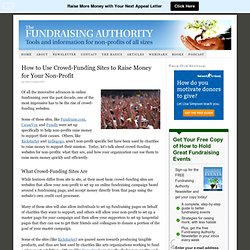

Shannon Whitehead. The creation of Kickstarter, Indiegogo, CrowdSupply, and other crowdfunding platforms, has opened the fashion industry to any aspiring designer with an internet connection.

Gone are the days of investors, banks, and loans. The money for producing your line can be acquired by complete strangers — who will actually become your first, and most valuable, customers. In 2010, I co-founded a Kickstarter campaign that became the highest-funded fashion project of the time — we raised $64,246 (over three times our goal amount) in 35 days. There were a number of factors that contributed to our success and virtually all of these steps can be taken by anyone looking to create a Kickstarter project. Based on my personal experience and a full year analyzing the factors of our success, I’ve written a 36-page, free guide to crowdfunding. The 7 Deadly Sins of Crowd Funding. 1.

GREED - It’s not just about the money! Crowdfunding gives you the chance to raise awareness and build an audience prior to - or while -working on your project. Many successful creators consider these benefits to be more valuable than the funding. Non-monetary benefits of crowdfunding include: Showing the world that you are not the only one to believe in your project (known as “third party validation” in marketing speak). 2. It is ALWAYS better to meet your target than not to meet your target.
Bear in mind you can always come back for another round of funding later. As to the precise amount: Be straightforward about your actual costs, this is what you need to raise. 3. The public loves to see your face on your crowdfunding campaign video (no really!). Film makers: you probably already have a great trailer, but experience shows that the public often prefers to see the women, men and passion at work behind your project. 4. Crowdfunding starts with your friends, family and existing fan base.
How to Use Crowd-Funding Sites to Raise Money for Your Non-Profit. Of all the innovative advances in online fundraising over the past decade, one of the most impressive has to be the rise of crowd-funding websites.

Some of these sites, like Fundraise.com, CauseVox and Fundly were set up specifically to help non-profits raise money to support their causes. Others, like Kickstarter and indiegogo, aren’t non-profit specific but have been used by charities to raise money to support their mission. Today, let’s talk about crowd-funding websites for non-profits: what they are, and how your organization can use them to raise more money quickly and efficiently. What Crowd-Funding Sites Are While features differ from site to site, at their most basic crowd-funding sites are websites that allow your non-profit to set up an online fundraising campaign based around a fundraising page, and accept money directly from that page using the website’s own credit card processor.
What Crowd-Funding Sites Are Not Which Crowd-Funding Site will Work For You? 1. Www.crowdfundingguides.com/The Crowdfunding Bible.pdf. Working the Crowd. What is crowdfunding, how does it work and is it right for your business or project?

Key findings Crowdfunding is a way of financing projects and businesses through small contributions from a large number of backers, rather than large amounts from one or a few sources.More than $2.7 billion was raised through crowdfunding globally in 2012.Campaigns can be based around donations, rewards, loans or equity investments. Crowdfunding is booming. In 2012, more than $2.7 billion was raised through crowdfunding worldwide – helping to fund more than one million new projects. The UK is also catching the crowdfunding wave, with £200 million invested through crowdfunding in 2012, and significant potential for further growth.
This short practical guide aims to gives a quick overview of crowdfunding, the different versions of the model and how they work. Authors Peter Baeck and Liam Collins. DIY Crowdfunding.